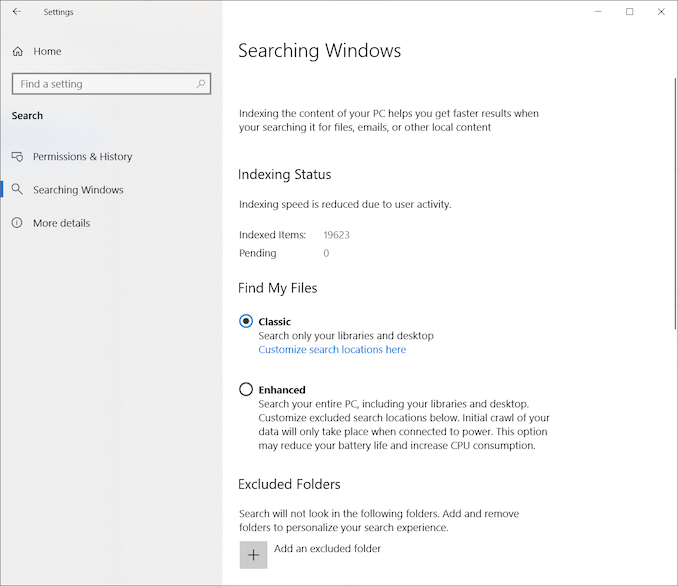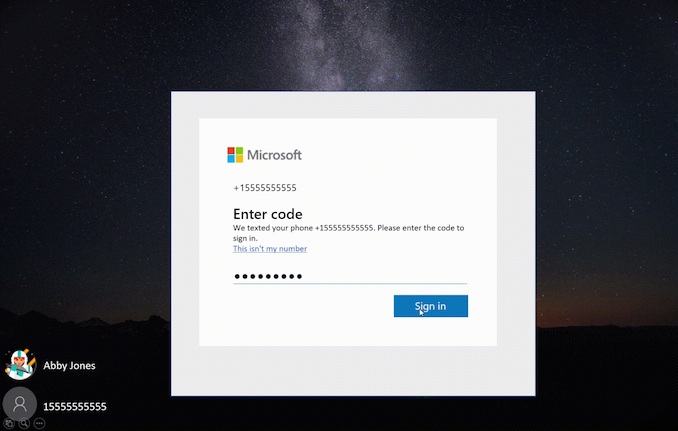Windows 10 May 2019 Update Feature Focus: Light Themes And Sandboxes
by Brett Howse on May 24, 2019 8:00 AM EST- Posted in
- Operating Systems
- Software
- Windows
- Microsoft
- Windows 10
Search and Cortana: Now just friends
Windows 10 has always included a search bar by default on the Windows 10 taskbar, but that search bar was tied into its Cortana virtual assistant. With Windows 10 May 2019 Update, Search and Cortana have officially split up, each getting their own location on the taskbar. You can of course customize that as well, and remove one or both if you’d like.
The new search has a landing page which quickly shows you recent files and top applications, so you can even use it as a condensed version of the Start Menu. Search has become an integral part of Windows since Windows Vista, when Microsoft started indexing applications and files for quick access by clicking Start and typing Notepad, as an example. The new Search offers more of that previous experience, while still offering web search for terms.
Cortana is still around, and is being integrated into Microsoft To-Do with this update. It seems like a more logical fit for it to be in a separate app than the default search, and it’s doubtful most desktop users will be upset by this change.
Search is also getting some a new settings page where you can see the current indexing status, as well as set up what folders you want to index, what folders you’d like to include, and more. This is part of Microsoft still trying to move the myriad of settings away from the older control panel style into the modern Windows 10 settings, where they work better with multiple input types. You can still access the old indexer options here as well, if you need to change something that you can’t do in the modern settings yet.
Signing In: Now with less passwords
Passwords are evil, and passwords have been proven again and again to not be a great way to secure things, so it’s great to see Microsoft offering a way to sign-in to Windows with a password-less account starting with the May 2019 update.
If you already have a Microsoft account, you can go to https://account.microsoft.com/account and sign in and then add your phone number to your account. If you don’t have a Microsoft account, you can create a new one based on your phone number.
Once your phone number is added, you can select your phone number when logging in and you’ll get a one-time SMS code on your phone which will let you log into the machine. Once logged in, you can set up Windows Hello with a PIN or PIN and facial recognition, and you’ll never need to enter a password to log in.
The Sign-In screen has also gotten some Fluent Design added to it, with an acrylic effect added when going to log in to focus your attention on the login box itself. It looks great.













71 Comments
View All Comments
haplo602 - Friday, May 24, 2019 - link
how about being able to remove driver updates from auto update ? if you ever had drivers from Windows Update, then reconsidered AFTER a CU, the system will treat those as a part of the base system from that time on ... no way to get rid of them ....KateH - Friday, May 24, 2019 - link
this. i'm not a huge fan of having to use group policy & registry workarounds to prevent Windows Update from bunging my graphics drivers every time i connect to the internetmikeztm - Friday, May 24, 2019 - link
They are fixing this the correct way: push every OEM to use DCH driver that is not modified and can be delivered from windows update. So OEM can put their driver customization separate and not affected by update.eastcoast_pete - Sunday, May 26, 2019 - link
+1 on this. Actually, + 1000. Very annoying when an "update" suddenly renders key peripherals inactive and unrecognized. Happened twice with one setup. Waste of time. Plus, if I could disable automatic driver updates, I just might be okay enabling automatic update on some machines. Without this, no way.Drazick - Friday, May 24, 2019 - link
I wish they dedicated the next 3-4 releases for only under the hood work:1. Reducing the number of background processes and memory consumption.
2. More modular Windows so user will be able to disable / remove components they don't need and optimize performance.
3. Optimize the IO stack so we'll have Linux like performance.
4. Optimize the File System so we'll have Linux like performance.
5. Ability to remove all pre installed components users doesn't want.
We want to be able to make Windows lean and efficient.
sorten - Friday, May 24, 2019 - link
Just curious, what performance metrics or tools are you using to measure the relative performance of the IO stack and file system between Windows and Linux?notashill - Friday, May 24, 2019 - link
I've never run detailed benchmarks or anything but my usual experience is that anything that has to access a bunch of small files (software compilation, extracting zips, etc.) takes something like 5-10x longer on Windows than Linux on the same hardware if it has an SSD. It's pretty ridiculous. Not much difference when hard drives are involved though.imaheadcase - Friday, May 24, 2019 - link
Thats more the UI stalling though that file system itself. Windows has always had a bad habit of not actually reporting correct numbers when transferring or doing tasks that appear on the actual screen. I often will move files around and UI will often hang for a bit and instantly show up correctly. Not saying its not slower, just saying the UI makes it a lot tricker to actually know.Drazick - Saturday, May 25, 2019 - link
We are talking about compilation. You can time when you started and when it is done. There is a big difference and Linux is faster. You can have a look on some tests made on Phoronix.leexgx - Saturday, May 25, 2019 - link
The delays will be when the antivirus is scanning the file its trying to copy (I norm just turn off antivirus scanner if I am doing large amount of files)